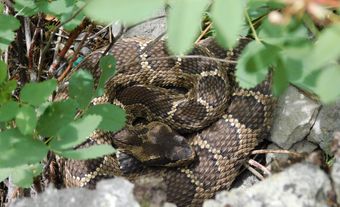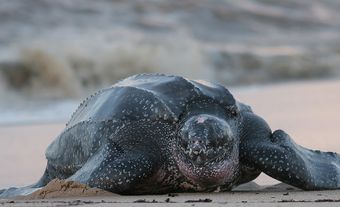Rattlesnake is the common name for about 30 species of venomous, viperid snakes in the genera Crotalus and Sistrurus, found from southern Canada to South America. Three species of rattlesnake are found in Canada: the Western rattlesnake (Crotalus oreganous), the prairie rattlesnake (Crotalus viridus) and the Eastern massasauga rattlesnake (Sistrurus catenatus). Another species, the timber rattlesnake (Crotalus horridus), is extirpated, meaning the species no longer exists in the wild in Canada but continues to live in the eastern United States.

Description
Features characteristic of rattlesnakes include a broad, triangular head with movable fangs, a stout body and a “rattle” made of modified scales, each of which once capped the tip of the tail. The buzzing sound produced by rapidly vibrating the tail is believed to be a defensive warning to intruders. Rattlesnakes have keeled scales and are pit vipers, meaning they have heat-sensing pits on either side of their face.
Distribution and Habitat
Three species of rattlesnake are found in Canada. The Western rattlesnake (Crotalus oreganous) lives in the arid grasslands of British Columbia. The prairie rattlesnake (Crotalus viridus) lives in similar habitats in Saskatchewan and Alberta. The Eastern massasauga rattlesnake (Sistrurus catenatus) lives in southern Ontario. A fourth species, the timber rattlesnake (Crotalus horridus), is also native to Canada but was extirpated. Rattlesnakes often hibernate communally in rocky outcrops.

Reproduction
Mating typically occurs in late summer, and fertilization takes place the following spring. In early fall, 2–10 (may be more in Eastern massasaugas) live young are born. Females reproduce only every 2–3 years. Their diet consists mainly of rodents, other small mammals and birds.
Venom
The venom used to kill prey is a mixture of neurotoxins and hemotoxins (affecting nerve and blood tissues, respectively) delivered through the fangs. Rattlesnakes rarely strike humans unless provoked or accidentally stepped on. The bite can cause painful swelling, muscular paralysis and tissue destruction and may result in death if untreated. However, less than 1 per cent of all snakebites in North America are fatal. The incidence of snakebite in Canada is very low.

Status and Threats
Like many other reptiles in Canada, Canadian rattlesnakes are considered at-risk species. The primary threats they face are persecution by humans, road mortality and habitat loss. The Western rattlesnake is listed as Threatened by both the Species at Risk Act (SARA) and the Committee on the Status of Endangered Wildlife (COSEWIC). The prairie rattlesnake is listed as a species of Special Concern by both SARA and COSEWIC. The Carolinian population of the Eastern massasauga rattlesnake is listed as Endangered by Species at Risk Ontario (SARO), whereas the Great Lakes-St. Lawrence population is listed as Threatened by SARO.

 Share on Facebook
Share on Facebook Share on X
Share on X Share by Email
Share by Email Share on Google Classroom
Share on Google Classroom




